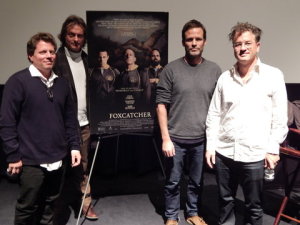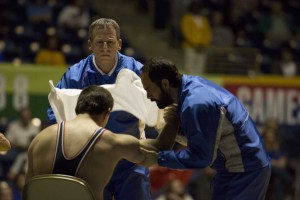
The Below The Line Screening Series presented Foxcatcher at the Landmark Theater Tuesday, Dec 16. A Q&A, featuring makeup department head Bill Corso, production designer Jess Gonchor, as well as editors Stuart Levy and Conor O’Neill, was held after the film.
A true story, Foxcatcher follows olympic gold medal-winning wrestler Mark Schultz (Channing Tatum), as he escapes poverty but ventures into a dangerous relationship with wealthy heir John uu Pont (Steve Carell), which leads to a tragic fate for his brother and mentor Dave Schultz (Mark Ruffalo).
Early on during production, conversations between director Bennett Miller (Capote, Moneyball) and Corso were focused on transforming Carell into Du Pont. Miller’s goal for Carell to disappear was achieved through prosthetics, painted skin and a hairline adjustment, supported by careful acting and directing. “All my work was put into trying to create a believable human being,” said Corso. “He was always du Pont when the cast and crew saw him.” Painting Carell’s skin took over an hour for each application, which only served Carell’s wish to be as isolated as possible to maintain the loner psyche of du Pont. Considering most are accustomed to Carell as comic, Corso shared Miller’s answer to initial questions of doubt regarding the actor’s dark diversion. “He (Miller) said, ‘let me worry about that. If we do the movie right, if Steve acts it right and I direct it right, and the performance and story works, they will believe. If you do your job and he looks like a real guy, they will believe him within the first minute.'”

Editing Foxcatcher was an emotional mission. According to Levy, Miller spent years with the script and, in terms of both directing and editing, was less concerned about the dialog within scenes than the feeling conveyed by the characters interacting. “It wasn’t about the words. It was about the feeling and what he was trying to achieve,” said Levy. “The words were there to bridge the gaps between looks, emotions, timing, glances and body language between characters.” O’Neill added, “We often talked about it as a tonal piece of music. It’s not about the individual movements or notes. It’s just this feeling that grows.” Levy and O’Neill further described the editing process as serving two masters, with Mark’s journey at the forefront, but du Pont’s progression toward manipulator as a strong motivator for the cut.
Foxcatcher hit screens Nov. 14 and is currently in select theaters.





